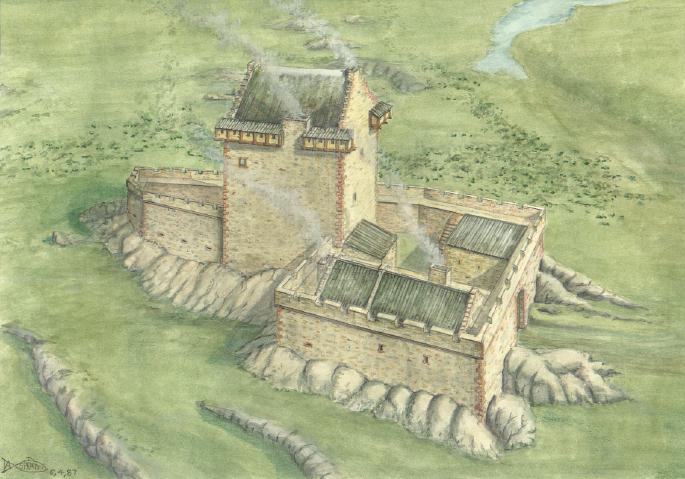 |
| Reconstruction
by Andrew Spratt |
Variously
referred to as Smailholm Castle and Smailholm Tower, all that remains is the
tower. The tower was once the centre of a thriving settlement. The west
courtyard was originally home to a hall and a kitchen, though in the 1650s
the hall was replaced by a house. Outside the barmkin wall would have once
stood cottages, stables and cattle enclosures, and traces of some of them
can still be seen on the ground. There would also have been a mill, on the
site now occupied by Sandyknowe Farm to the south east of the tower. The
millpond still exists.
Smailholm Tower
is a peel tower that stands around five miles west of Kelso in the Scottish
Borders. Its dramatic situation, atop a crag of Lady Hill, commands wide
views over the surrounding countryside. The tower is located just west of
Sandyknowe farm and is now a Scheduled Ancient Monument in the care of
Historic Scotland.
Smailholm Tower was originally built in
the 15th century or early 16th century by the Pringle family. Followers of
the Earl of Douglas, the Pringle (anciently spelt Hoppringle) family had
held the lands of Smailholm from the early 15th century, and managed part of
Ettrick Forest for their feudal superior.
Smailholm Tower was designed, in common
with all Scottish peel towers, to provide its occupants with protection from
sporadic English raids.
In 1645 the tower was sold to Sir William Scott. The Scott's built a new
house in the West Courtyard. This remained in use until the early 1700s,
when the family moved to a more comfortable and less exposed house they
built a few hundred yards to the south east at Sandyknowe.
Note: George Pringle was appointed Master Ranger of the Tweed Ward and
David of Pilmuir Ranger. Robert Pringle of Wrangholm (North West of
Smailholm) took over as Master Ranger from George. David continued under
him as Ranger. But David later obtained the western half of Smailholm
probably from George in the 1460s. Cristopher J Trabraham (Historic
Buildings & Monuments) states 'On the question of the date of construction
of the Tower, I do agree with you that a post-1455 date seems highly
suspect ... all the bits and bobs of evidence would seem to endorse your
view that we have in Smailholm a towerhouse from the early 15th century'.
He goes on to say how similar Smailholm is to the Douglases' own residence
in the Forest - Newark Castle in almost all respects other than scale and
he does not think the two are coincidental.
Contributed by James B Pringle, trustee of the Clan Pringle Association:
George Douglas squire and master ranger of the Tweed ward with David
Hoppringill of Smailholm the ranger continued his support for Douglas and he
(George) and his son Thomas lost their lands of Philiphaugh ln 1460/1, which
were granted to Murray.
See also:
• Pringle of
Whitsome
• Borders Tower Houses
|
|


